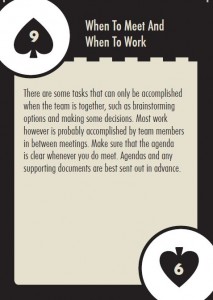
Thanks to http://thegoldguys.blogspot.com/
While some teams stay together for years, others need to come together and deliver results quickly. These top 5 tips are taken from our Teamwork cards. Each of the following tips also has a full blog post to support it, should you need more detail.
- Ace of Hearts – Develop a Shared Vision – There is no one right way to develop a shared vision but sometimes approaching it indirectly can be easier for people. Have each member of your team answer the following questions. Once everyone has identified their responses, have a team discussion and see what emerges as a result. This can lead to a vision statement in a more concrete way than just asking people to describe their vision. Think back to a great team experience. Describe that experience. What was it about that experience that was so positive? How did it differ from other team experiences? How can this team create that kind of experience? What would we commit ourselves to? What values would we demonstrate?
- Jack of Spades – Play to your Strengths – Everybody performs better when they play to their strengths. Make sure that individuals’ strengths are taken into account when roles are assigned and tasks allotted. One way to do this would be to have the team discuss what strengths would be needed to accomplish a role or task before it is allotted. Also check out Gallup’s Strengths Finder book for a more formal approach to discovering your strengths.
- Ace of Spades – Accountability – Knowing who is responsible for what is vital to a team’s success. It’s very easy for these accountabilities to be too vague, especially when there are changes in team membership. Who is responsible for what is the most important thing to have documented at the end of any team meeting.
- Ace of Clubs – Deciding how to Make Decisions – One of the most important things a team leader does is decide how best to make any particular decision. There are numerous decision making strategies such as democratic, consensus, and autocratic, but knowing which to use in any particular context is the real key to successful decision making on teams. Leaders should pay particular attention to the number of people involved and the magnitude of the impact of the decision when selecting a decision making strategy.
- Nine of Hearts – Be Present –People have become accustomed to being constantly connected to email no matter where they are. While some people can be effective multi-taskers, sometimes this pre-occupation with mobile devices can be a way to avoid unpleasant conversations and/or distract you from important activities and conversations. Monitor your “presence” and that of your team members, and use technology wisely. What message are you sending with your Blackberry use?
This blog post is inspired by Teamwork Explorer – an iPhone app. Along with this “winning hand” for a new team, the app features 12 other common team challenges and offers solutions for each.
